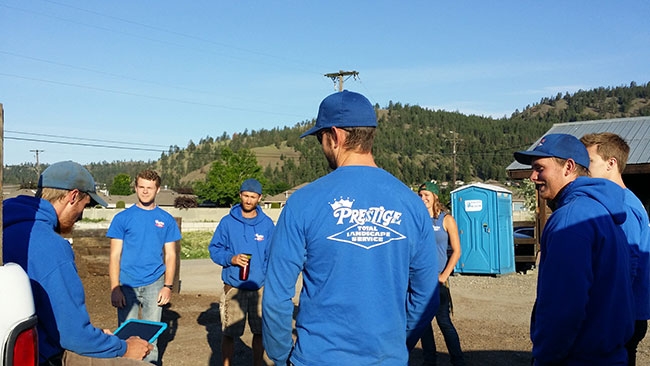
Features
Profiles
Health and Safety: ‘Toolbox talks’
‘Toolbox talks’ promote safety among turf industry workers
May 8, 2018 By By the CCOHS
 A landscaping firm’s employees gather around for a morning ‘toolbox talk.’
A landscaping firm’s employees gather around for a morning ‘toolbox talk.’ You may know them as morning check-ins, tailgate meetings, safety briefings, or toolbox talks. You may have had one this morning. Though the names may be different, they are all brief, safety-focused discussions among managers or supervisors and workers.
Toolbox talks can be an effective means for promoting a strong safety culture by keeping workers and supervisors up-to-date and informed about safety concerns, relevant procedures and topics.
Why do we call them toolbox talks?
The name toolbox talks likely comes from the original location of many workplace safety talks, which was around the toolbox to talk about workplace hazards and safety. Though these discussions can go by a variety of names, they share the goal of identifying hazards in the workplace and communicating to workers what is done to mitigate those hazards.
Who should lead the toolbox talk?
Supervisors commonly lead toolbox talks, but any subject matter experts available at the worksite can lead such a discussion. Any qualified management representative can give direction to employees (site supervisors, foremen, general manager, etc.). Other workers at the site can share their knowledge, skills and experience.
You may wish to look to experts in your group, i.e. a safety officer or safety adviser. These individuals may have interesting and relevant examples from their daily inspections or routines to share. Involving all workers helps to ensure that all hazards are identified so that workers can perform their tasks safely.
How often should they be held?
Holding a daily talk is a good idea. High-risk industries tend to have a safety meeting every morning before the shift starts on a different topic or piece of safety information.
Industries and workplaces with a high employee turnover or changing work environments should schedule more frequent meetings to account for this change.
How long should these talks be?
A toolbox talk needs to be long enough to clearly identify the hazards, the risks, and how you’re going to control those hazards. There should be an opportunity for some discussion, questions from workers and responses from the employer representatives. Remember, a toolbox talk is not a substitute for training. Employers must ensure that workers receive training for the jobs they’re performing to work safely.
Where and when should these discussions take place?
Meetings are best held in a comfortable location at the beginning of a shift, after lunch or a break, or incorporated into another operational meeting. Be aware that noise levels or other factors nearby don’t create distractions for the participants.
Tips for effective talks:
- Prepare in advance
- Allocate a sufficient amount of time – remember to allow for time to answer questions!
- Ensure all workers are involved in the talk
- The topic must be relevant to workplace safety
- Focus on identifying hazards and risks
- Include controls that can be put into place to mitigate hazards and risks
- Use subject matter experts
- Lead by example
- Keep the participants focused on safety – be careful not to become distracted by other unrelated topics/issues/complaints
Does everyone need to attend?
Yes, everyone should be required to attend the talk. That way, everybody involved knows what the risks and hazards are in the work that is about to be done and they have the ability to do the job safely. Tracking attendance at the talk ensures that you know that the person you’re sending off to do the task has the information they need to work safely.
7 Guidelines for preparing toolbox safety talks
1. For each discussion or talk, focus on one idea (hazard or job-related task).
2. Select a key topic to discuss (i.e. a hazard workers need to understand and can relate to):
- Consider your own experiences, observations, and beliefs
- Think of your area of control, repeated problems, recent accomplishments, and areas for improvements
- Think of the workers, what they want and need, opinions, accomplishments, and areas for improvements
- Keep notes of day-to-day occurrences so you can address them in timely safety talks
- Read safety-related material, bookmark occupational health and safety websites, research and save news articles
3. Summarize your talk in point form
- Know what you’re going to say
- Write down key points, facts, and examples
4. Practice your talk
- Run through your material before your present it to your workers. Over time this will get easier.
5. Make toolbox talks a scheduled and regular part of the work day and if needed, before starting a particular task.
6. You should:
- Have the immediate supervisor conduct the meeting
- Make them short and to the point
- Focus on one topic but cover it in as much detail as necessary to convey the safety information
- Have an agenda to keep the talks on track
- Document the talk and maintain a record in your business files
7. Toolbox safety talks, like all safety meetings, are critical to the employer’s health and safety program and establishing due diligence. Using a logbook is the best way to document that you conduct safety talks, what topics are covered and who attended.
Print this page